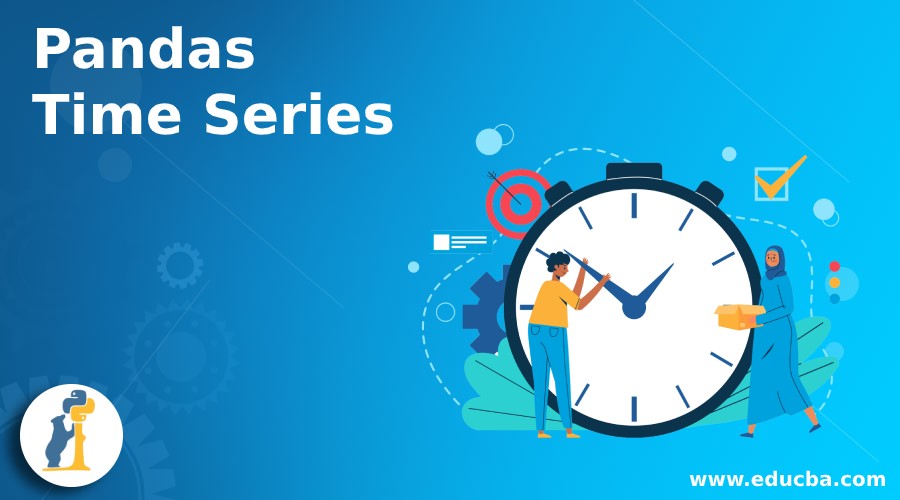Updated April 12, 2023
Introduction to Pandas Time Series
Pandas Time Series information has been incredibly effective in the financial-related information examination space. Utilizing the NumPy datetime64 and timedelta64 data types, we have merged an enormous number of highlights from other Python libraries like scikits.timeseries just as made a huge measure of new usefulness for controlling time series information. Pandas has demonstrated exceptionally effective as an instrument for working with Time Series information because Pandas has some built in ‘datetime’ capacities which makes it simple to work with a Time Series Analysis, and since time is the most significant variable we work with here, it makes Pandas a truly appropriate instrument to perform such examination.
How do Time Series work in Pandas?
Given below are the examples mentioned:
Example #1
Code:
To create all dates in a Dataframe.
import pandas as pd
data = pd.date_range('1/1/2010', periods = 5, frequency ='H')
print(data)Output:
In the above code, we see that we would like to implement the dates in the dataframe. Here, we first import pandas as pd and then we create the dataframe with the dates. Then print the data that we created. Hence in the output it shows the number of time periods we wanted to print this date and also the frequency as H.
Example #2
We separated the dates in the dataframe into different modules.
Code:
import pandas as pd
range = pd.DataFrame()
range['date'] = pd.date_range('1/1/2010', periods = 65, frequency ='H')
range[:4]
range['year'] = range['date'].dt.year
range['month'] = range['date'].dt.month
range['day'] = range['date'].dt.day
range['hour'] = range['date'].dt.hour
range['minute'] = range['date'].dt.minute
print(range.head(4))Output:
In the above time series program in pandas, we first import pandas as pd and then initialize the date and time in the dataframe and call the dataframe in pandas. This is done by making use of the command called range. Then we declare the date, month, and year in dd-mm-yyyy format and initialize the range of this frequency to 4. Finally, we use the range command to initialize the date, month, year, hour, and minute. Finally we print all the data into multiple features and finally the output is given.
Time Series Analysis in Pandas:
- Time series causes us to comprehend past patterns so we can figure and plan for what is to come. For instance, you own a coffeehouse, what you would almost certainly observe is what number of espresso you sell each day or month and when you need to perceive how your shop has performed in the course of recent months, you are likely going to include all the half-year deals. Presently, imagine a scenario where you need to have the option to conjecture deals for the following a half year or year. In this sort of situation, the main variable known to you is time (either in a moment or two, minutes, days, months, years, and so on) — subsequently you need Time Series Analysis to foresee the other obscure factors like patterns, irregularity, and so forth.
- Time Series is a lot of information focuses or perceptions taken at indicated times as a rule at equivalent spans (e.g hourly, every day, week after week, quarterly, yearly, and so forth). Time Series is typically used to anticipate future events dependent on past watched event or qualities. Foreseeing what might occur in the securities exchange tomorrow, volume of products that would be sold in the coming week, regardless of whether cost of a thing would soar in December, number of Uber rides over some stretch of time, and so on, are a portion of the things we can do with Time Series Analysis.
When should we not use Time Series in Pandas?
- The factors/values are steady. For instance, 5000 boxes of confections where sold last Christmas, and the Christmas before that. Since the two qualities are equivalent, we cannot make a different time arrangement to anticipate deals during the current year’s Christmas.
- Qualities as capacities. There’s no point applying Time Series Analysis to a dataset when you can figure esteems by just utilizing a recipe or capacity.
Conclusion
A prescient examination is profoundly significant in the data science field and time-series information is at the center of numerous issues that prescient investigation intends to comprehend. Thus, on the off chance that you intend to work in the field of prescient examination, you should figure out how to deal with time-series information. There are numerous meanings of time arrangement information, all of which show similar importance in an alternate manner. A clear definition is that time-series information incorporates information guides appended toward consecutive time stamps. The wellsprings of time arrangement information are occasional estimations or perceptions.
Recommended Articles
We hope that this EDUCBA information on “Pandas Time Series” was beneficial to you. You can view EDUCBA’s recommended articles for more information.




